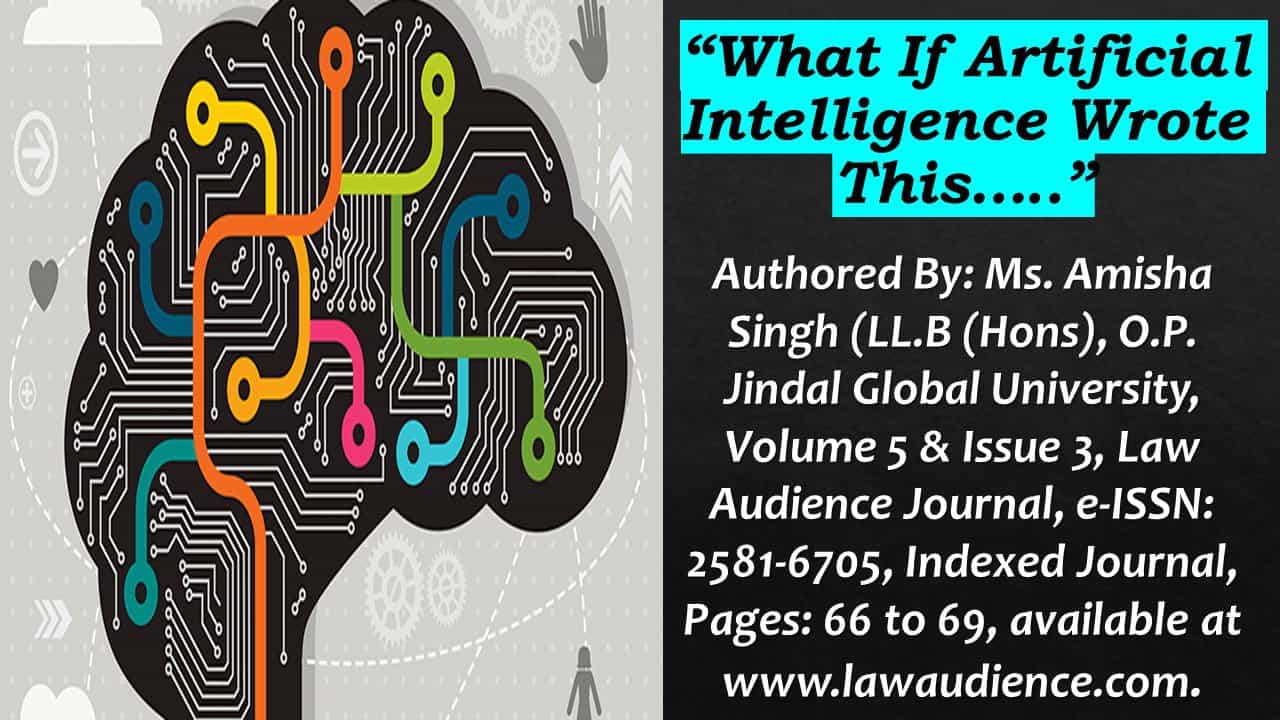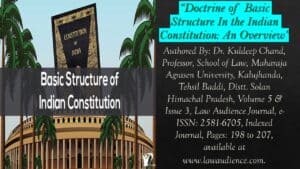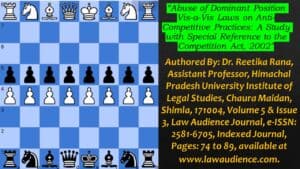Click here to download the full paper (PDF)
Authored By: Ms. Amisha Singh (LL.B (Hons), O.P. Jindal Global University,
Click here for Copyright Policy.
I. INTRODUCTION:
The rapid advancement of Artificial Intelligence (AI) technology has ushered in a new era of creative collaboration between humans and machines, giving rise to a plethora of AI-generated works across various domains. However, this technological revolution has brought with it a complex web of legal and ethical challenges, particularly in the realm of intellectual property (IP) rights ownership. The issue of determining rightful ownership and ensuring just compensation for creations produced by AI or in collaboration between human and AI actors has become a focal point of debate. This essay delves into the intricate landscape of IP ownership in AI-generated works and proposes an innovative policy framework to address the multifaceted challenges that arise.
As AI systems contribute increasingly intricate and influential roles in the creative process, traditional notions of authorship and ownership require revaluation. The proposed framework offers a solution that both recognizes and rewards the contributions of both human creators and AI systems, while fostering a conducive environment for innovation and collaboration. The emergence of AI-generated works has blurred the lines between human and machine contributions, posing significant questions regarding IP ownership. As AI algorithms evolve to autonomously generate music, art, literature, and other forms of creative content, identifying the rightful creators becomes a complex puzzle. Furthermore, collaborative projects that meld human ingenuity with AI capabilities complicate the ownership equation, necessitating a nuanced approach that respects the creative input of all parties involved. Several policy proposals have surfaced to address this conundrum, yet a consensus remains elusive. The existing landscape lacks a cohesive, internationally accepted framework that ensures equitable compensation and recognition for all stakeholders. This paper confronts this challenge by introducing a novel policy recommendation aimed at shaping the future of AI-generated work ownership.
II. ANALYSIS OF POSSIBLE APPROACHES DEALING WITH OWNERSHIP OF PRODUCT CREATED BY ARTIFICIAL INTELLIGENCE:
As the development of artificial intelligence (AI) technology continues to ad- Vance, the issue of ownership of intellectual property (IP) rights for works created by AI or in collaboration between human and AI becomes increasingly complex. While there have been several policy approaches suggested to regulate IP ownership in AI-generated works, there is still a lack of clarity in how to assign ownership and ensure that all stakeholders are compensated. In this essay, the author a specific and innovative recommendation for a policy framework that could be used to regulate IP ownership for AI-generated works. The recommendation is to establish a new legal framework that assigns joint ownership of IP rights to both the human and the AI system that contributed to the creation of a work. This approach acknowledges the contributions made by both human and AI creators and provides a framework for fair compensation and recognition of both parties. Joint ownership also encourages collaboration and innovation by incentivising humans and AI to work together to create high-quality works. To implement this framework, new legislation would need to be developed to establish the legal status of AI-generated works and the rights and responsibilities of creators. This legislation should be developed in consultation with stakeholders including AI developers, artists, writers, and other creators who may be impacted by this new framework. Additionally, guidelines should be developed to ensure that joint ownership of IP rights does not create any conflicts or disputes between humans and AI, and to ensure that creators are fairly compensated for their contributions.
One potential challenge with this framework is how to determine the relative contributions of human and AI creators. This could be addressed by developing a set of guidelines or criteria to determine the level of contribution made by each party. For ex- ample, if a human artist provides the initial concept or inspiration for a work, but an AI system generates the final product, the guidelines could consider the level of creativity and originality of each contribution, as well as the complexity of the AI algo- rhythms used to generate the work. Another challenge is how to establish fair compensation for each party. One possible solution would be to use a profit-sharing model, where profits from the sale or licensing of an AI-generated work are split between the human and AI creators accord- ing to their respective contributions. Alternatively, a fixed fee or royalty system could be established based on the level of contribution made by each party. This new policy framework for IP ownership of AI-generated works has several advantages. Firstly, it recognizes the value of both human and AI contributions to the creation of works. Secondly, it provides a framework for fair compensation and recognition of creators. Finally, it encourages collaboration and innovation by incentivizing hu- mans and AI to work together to create high-quality works. In this approach, the establishment of joint ownership of IP rights for AI-generated works is a new and innovative approach that can provide a framework for fair compensation and recognition of both human and AI creators. While there are challenges to implementing this framework, careful consideration and consultation with stakeholders can help to address these challenges and ensure the continued development of AI technology in a responsible and equitable manner.
An alternative perspective on ownership is the expansion of the best solution that argues for releasing the work into the public domain. However, instead of releasing the work immediately, the author recommends a buffer period of, for instance, fifteen years before the art enters the public domain. The buffer period provides a transitional period for the creator to benefit from the work while also addressing the concerns of ownership and control. During this period, the creator can monetize their work through various means, such as licensing and selling the work to interested parties. This approach recognizes the creator’s efforts and contributions to the work while still ensuring that the public can access it later. Moreover, after the stipulated time, the ownership of the work and the funds generated from the work from that time onwards could be used for charitable purposes. This approach promotes the public interest by ensuring that the benefits of AI-produced work accrue to society, rather than just the creator or the own- er. Charitable organizations could use the funds generated from the work to support social causes, such as education, healthcare, and poverty alleviation. In addition to promoting public interest, this approach also addresses the issue of AI-produced work being owned and controlled by a small group of individuals or corporations. By introducing a buffer period and subsequent transfer of ownership to charitable organizations, the approach ensures that the work is not solely owned and controlled by a few entities, thereby democratizing access and control. One potential challenge with this framework, is that it could easily become a tool to convert black money into white as observed with art. However, as these are digital, they have higher chance of regulation and has a greater ability to be traced back and investigate the chain of ownership. In this approach, the issue of ownership of AI-produced work requires a nuanced and well-thought-out approach that balances the interests of creators, owners, and the public. An alternative perspective is to introduce a buffer period before releasing the work into the public domain and transferring ownership and funds generated from the work to charitable organizations. This approach recognizes the efforts of the creator while promoting public interest and democratizing access and control.
III. CONCLUSION:
Artificial intelligence is an emerging Technology, and it comes with a set of challenges for creating a framework to govern copyright and ownership laws with reference to work created by artificial intelligence. There are many possible frameworks that can help create laws in this regard and each framework comes with its own set of pros and cons. At this point of time, it is hard to predict which framework will work the best and if there is a framework that works the best there is always a chance that artificial intelligence will eventually outgrow it making the framework redundant again, causing the policy makers to start from square one.
Cite this article as:
AMISHA SINGH, “What If Artificial Intelligence Wrote This”, Vol.5 &
Issue 3, Law Audience Journal (e-ISSN: 2581-6705), Pages 66 to
69 (4th September 2023), available at
https://www.lawaudience.com/what-if-artificial-intelligencewrote-this/.



